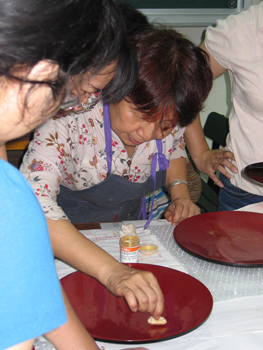Learning about Lacquer
Authentic bamboo arts and crafts, together with the art of lacquerware, make a great combination. I have always had intense interest in, and enthusiasm for, educational work. After graduating from art school. I first taught arts and crafts in my home town in Pingtung County. After marrying, I became a high school teacher in Chushan, Nantou County. I found Takeyama to be rich in bamboo, with a well developed bamboo processing industry, and was quite taken with the bamboo craft. Though a student of decorative art, I had not been familiar with bamboo crafts. The demands of the school curriculum brought me together with the Chushan bamboo craftsman, Master Huang Tu, whose family had won the Art Heritage Award-Folk Art-with Honors. Teaching students and encouraging them to pursue their own development, I thus learned something of bamboo crafts and gained an initial understanding of Taiwanese bamboo processing technology. |
 |
I reluctantly left teaching in 1976 to enter the Taiwan Provincial Handicraft Research Institute (now the National Taiwan Craft Research Institute). There I began research and innovation in bamboo craft, and became responsible for encouraging firms to design and develop related products.
I had an interest in bamboo due to my Chushan experience, and further knowledge of the material and its processing drew me to the design of bamboo products. I wanted to upgrade the technology. I studied rattan processing by learning the technique alongside skilled workers in a rattan factory. The instructors were quite willing to teach me, even seeing in their work a civic service.
That factory did export business with Japan. The Japanese are very strict in supervising quality control. If a wicker chair fell outside the specifications, one would apply the shears and begin entirely afresh. Such an environment provided little in the way of learning new techniques, but did offer very solid technical training.
Business relationships growing out of that work brought me together with Chunan Kuribayashi, a basketry teacher who had won the Heritage Award and the Ministry of Education's National Technology Award. I cooperated closely with him in detailed and frequent study and research on Saisiyat rattan. Then, combining bamboo and rattan materials developed for the Kuribayashi bamboo flower chandelier, I earned the award for a prize work bestowed by the Taiwan Handicraft Exhibition.
Another result of fostering firms' performance in this area was a highly stimulating month spent in Japan. It was the first time I had been to Japan. At that time it was not easy for one in the civil service to travel abroad. That trip abroad exposed me to different cultures, and, especially, to Japanese flower arrangement and the use of multi-coated paint to produce very beautiful objects. These traditions of Oriental beauty, with the warm feeling of that distant realm, impressed me deeply and would be among the reasons for my future study of lacquer art.
My chief work at the Handicraft Institute was development of bamboo products. There are limits to the way one may process and use bamboo, especially in view of its hollow section. Nevertheless, Taiwan from the beginning has had a rich bamboo production. How to adapt traditional bamboo products to modern life, and add to their value, became the subject of my work.
I know that bamboo is not dense in its microscopic structure. It has a high water content, is vulnerable to insects, wears easily, and has limited life expectancy. How to strengthen bamboo, enhance its durability, and give bamboo products a new look? This led me naturally to painting. However, at that time I had little practical familiarity with the use of lacquer.
I might have had a true affinity for painting, but only over time would it come to fruition. In 1984, the Handicraft Institute's "Exhibition of Techniques in Japan" displayed my bamboo work which included, for the first time, painted products.
Handicraft makes working with the Institute benefited from the cooperation of the Fengyuan lacquerware industry. This included the three companies headed by the Chinese lacquerware factory owner Liu Qinglin. Thus I had my introduction to the rich technique of Master Chen. Visits to his home, where I saw noble and beautiful lacquer colorwork and a wide display of techniques, marked the beginning of my real contact with lacquer.
Master Chen represents the Japanese colonial era in Taichung City. He built a solid foundation in lacquerware arts are Taiwan's only surviving national treasure in lacquer. There is in Master Chen's lacquer work a beauty which amazes me, along with special feeling of warmth, and even the gorgeous beauty of the National Palace Museum's lacquerware is not the same.
Thus deeply moved, and knowing product performance could improve through coating, I came to worship Chen as a teacher, and followed him to learn lacquerware. In 1984, then-director Chuan Xiaobo approved and organized a "Chinese Lacquerware Teaching Workshop" and invited Chen to teach it. Thus began rapid progress and development in lacquerware art.
Chen, even after having taught for seven years, still wrote personal notes to the Institute every week on the two class days, before and after class during the last three years, per one of my students. Eventually, other participants, due to the story allergic reaction associated with lacquer or to the pressured of other commitments, discontinued their studies, leaving me as Chen's only apprentice. Following him longest, I was also fortunate to learn the most of his technique.
(Interviewed and edited by Chung-wen Yang)



